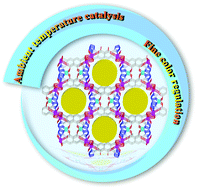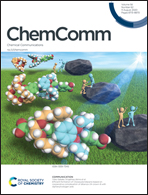Highly stable 3D porous HMOF with enhanced catalysis and fine color regulation by the combination of d- and p-ions when compared with those of its monometallic MOFs†
Abstract
In this study, two new monometallic organic frameworks (MOFs), namely {[Zn1.5L(NMP)(H2O)]·H2O}n (1) and {[Pb2L2(H2O)2]·H2O}n (2), were synthesized for the first time by a new bifunctional N,O-containing 2-(1H-tetrazol-5-yl)terephthalic acid (H2L) ligand. Then, based on the HSAB principle, another porous Pb–Zn heterometallic organic framework (HMOF), namely {[PbZn0.5L(H2O)]·0.5NMP·H2O}n (3), was successfully obtained for the first time by combining Pb(II) and Zn(II) ions with H2L. The MOFs 1 and 2 are 3D densely packed frameworks, whereas the HMOF 3 is a porous 3D framework (28.9% porosity) with 1D open channels modified by Lewis basic sites (exposed N atoms) and Lewis acidic sites (unsaturated bimetallic sites). The HMOF 3 has a strong boiling water/acid–base resistance (pH = 2–12) and shows an enhanced high-efficiency catalytic effect for CO2 conversion (98%) under ambient temperature and pressure conditions. In addition, fine color regulations of the MOFs were successfully realized by doping different kinds of metal ions into them. This study aims to provide a new way and field of vision for the construction of HMOFs and their multi-functional materials.

- This article is part of the themed collection: Functional Coordination Networks


 Please wait while we load your content...
Please wait while we load your content...